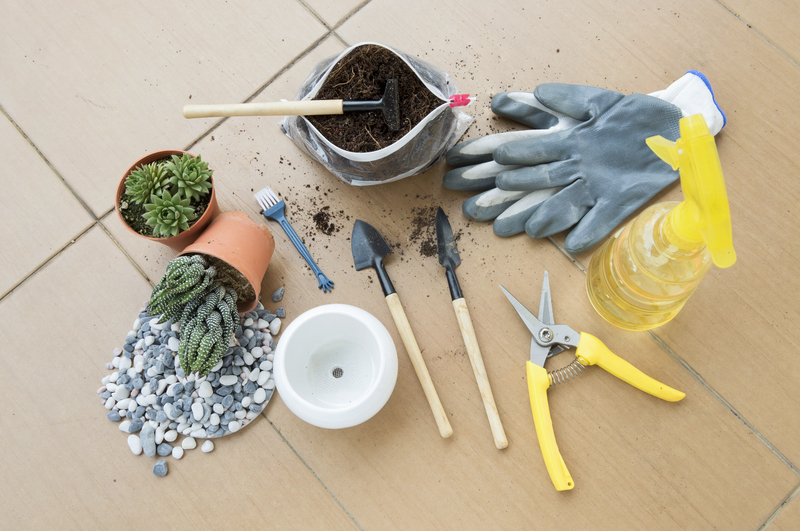Protective Measures for Garden Plants During Winter
Posted on 16/06/2025
Protective Measures for Garden Plants During Winter
Winter can be a challenging time for gardeners. Freezing temperatures, strong winds, heavy snowfall, and occasional ice storms threaten the survival of garden plants. When the cold season approaches, it's crucial to take effective protective measures for garden plants during winter to ensure your favorite flowers, shrubs, and trees make it through until spring. This comprehensive guide will walk you through every step and technique needed to keep your garden thriving, no matter how harsh the winter gets.
Why Do Plants Need Protection in Winter?
Understanding why protecting garden plants during winter is important will help you take the right steps. Most plants experience stress during winter, primarily due to:
- Extreme temperature fluctuations -- Sudden shifts between warm daytime and freezing nighttime temperatures can damage plant tissues.
- Desiccating winds -- Winter winds rob the soil and plants of moisture, causing dehydration.
- Frost and ice -- These can break branches, destroy buds, and kill roots.
- Heavy snow -- Accumulated snow may snap branches and crush stems.
- Soil heaving -- Repeated freezing and thawing can push roots out of the ground, exposing them to severe cold.
Winter damage can result in stunted growth, fewer blooms, or even death. Effective winter garden plant protection minimizes these risks and promises a healthy, vibrant garden come spring.

Planning Ahead: Preparing the Garden for Winter
The key to strong winter protection for garden plants is early preparation. Below are some steps to take in late fall, before the harshest conditions arrive:
1. Assess Plant Hardiness
Check the hardiness zone of each plant. Plants less hardy than your local climate are at the greatest risk and require more attention.
2. Cut Back and Clean Up
- Remove all diseased or dead plant material to prevent overwintering pests and diseases.
- Leave seed heads for birds and beneficial insects, but prune long, vulnerable stems prone to breaking.
3. Stop Feeding and Pruning
Cease fertilizing and pruning by mid-fall so plants aren't encouraged to produce tender new growth easily damaged by frost.
4. Deep Watering
Hydrate your plants thoroughly before the ground freezes. Moist soil retains heat better and aids roots in surviving subfreezing temperatures.
Mulching: The First Line of Defense
One of the best winter protective measures for garden plants is proper mulching. Mulch acts as insulation, moderating soil temperature and moisture.
- Apply mulch after the first hard frost but before the ground is frozen solid. This timing prevents rodents from nesting in the mulch.
- Use organic materials like shredded leaves, pine needles, straw, or wood chips.
- Apply 2-4 inches of mulch around perennials, not touching the stems to avoid rot.
- For tender plants, form mulch "cones" or "hills" for extra insulation.
Mulch also helps prevent soil heaving by keeping temperatures stable, ensuring roots remain safely underground.
Physical Barriers: Shields Against Wind, Snow, and Ice
Protecting plants from winter weather often means setting up physical defenses. Here's how you can shield your garden:
1. Burlap Wraps and Screens
- Wrap shrubs and young trees with burlap or horticultural fleece to protect them from wind and sunscald.
- Erect burlap screens on the windy side of exposed beds.
- Burlap also works to guard evergreens from drying winter winds and heavy snow.
2. Cloche, Row Covers, and Cold Frames
- Use cloches (glass or plastic domes) on delicate perennials or annuals overwintering outdoors.
- Floating row covers help retain warmth and moisture over vegetable beds.
- Cold frames act as mini-greenhouses protecting tender greens and early sprouting bulbs.
3. Tree Guards and Mulch Collars
- Young trees benefit from plastic or mesh tree wraps that fend off frost cracking and nibbling rodents.
- Lay extra mulch collars around shrubs and roses for additional root protection.
Watering - Yes, It's Still Important!
Many gardeners mistakenly assume watering stops in winter. But adequate soil moisture is crucial for plant survival.
- Water evergreens and recently planted trees and shrubs until the ground freezes.
- On warmer winter days, water if soil is dry and not frozen.
- This keeps roots hydrated and prevents winter burn.
Wind Protection for Delicate Plants
Wind-borne moisture loss is a leading cause of winter damage in garden plants. Here's how to deal with it:
- Group container plants together to create a self-sheltering "microclimate."
- Erect temporary windbreaks using snow fencing, lattice panels, or stacked hay bales.
- Move sensitive potted plants into sheltered spots near walls or under eaves.
Protecting Evergreens During Harsh Winters
Evergreens are at risk because their leaves or needles continue to transpire even in winter. This makes evergreen protection essential:
- Spray anti-desiccants (available at garden centers) on broadleaf evergreens to slow water loss.
- Burlap wraps or shading cloth minimizes sunscald and windburn on boxwoods, hollies, and rhododendrons.
- Watering during winter thaws replenishes lost moisture and prevents root desiccation.
Special Care for Container Plants
Containers expose roots to colder air temperatures than in-ground plants. For potted plant winter protection, follow these steps:
- Move containers against heated walls or into enclosed porches, garages, or sheds.
- If left outdoors, cluster pots together and surround them with mulch, straw, or bubble wrap for insulation.
- Elevate the pots from cold ground to prevent waterlogging and freezing roots.
- Consider sinking pots into garden beds and mulching over the top.
Pruning and Structural Support
Pruning in late fall reduces breakage from snow and ice. However, avoid heavy pruning in late autumn, as it may encourage tender new growth.
- Remove dead, diseased, or crossing branches.
- Stake young trees or top-heavy shrubs to prevent windthrow and splitting.
- Brush snow off evergreens with a broom to prevent limbs from bending and snapping.
Protecting Perennials, Roses, and Bulbs
Perennials
- Cut back herbaceous perennials after foliage dies and mulch over crowns.
- For borderline-hardy varieties, mound extra mulch or leaves several inches deep.
Roses
- Hill up 8-12 inches of soil and mulch around the base of hybrid tea and floribunda roses.
- Cover rose crowns with rose cones or burlap for improved rose winter protection.
Bulbs
- Layer mulch over newly planted bulbs to prevent freeze-thaw cycles from exposing them.
- Lifting and storing tender bulbs (like dahlias and cannas) indoors through the coldest months is recommended in frigid climates.
Winterizing Vegetable Gardens
Protecting vegetables overwintered in the garden ensures early spring harvests and healthier soil. Here's what to do:
- Harvest the last tender crops before hard frost strikes.
- For overwintered root crops (carrots, parsnips), blanket beds with hay or straw.
- Plant cover crops or apply mulch to vegetable beds to prevent soil erosion and suppress weeds.
- Use low tunnels or cold frames to keep leafy greens and brassicas protected.
Identifying and Addressing Common Winter Problems
Even with the best winter plant protection techniques, issues can arise. Watch for:
- Sunscald -- Cracks on tree bark from sudden warming -- Use wraps and shade to minimize.
- Rodent Damage -- Mice, voles, and rabbits chew bark and roots -- Protect with tree guards and avoid piling mulch too deep.
- Fungal Diseases -- From wet, mild spells -- Ensure proper airflow and avoid over-mulching.
Spring Recovery: Caring for Plants After Winter
Your work doesn't end at winter's close. When temperatures begin to rise, follow these steps for the best results:
- Gradually remove heavy winter mulch as the ground thaws and new shoots appear.
- Remove wraps, screens, or windbreaks on a cloudy day to prevent sunburn.
- Inspect all plants for winter damage and prune dead or broken growth.
- Apply a balanced fertilizer when you see signs of new growth.
- Water thoroughly if the soil is dry to kickstart spring recovery.

Frequently Asked Questions
How can I protect my plants from frost?
To protect garden plants from frost, cover them at night using garden blankets, row covers, old sheets, or even upturned buckets. Remove covers in the morning to prevent overheating.
What's the best type of mulch for winter?
Shredded leaves, straw, pine needles, and wood chips are best for winter mulching. Avoid non-breathable materials (e.g., plastic sheeting) that trap moisture and encourage rot.
Should I fertilize in winter?
No. Avoid fertilizing plants in fall or winter. Fertilizer can prompt new growth that is likely to be killed by frost.
How do I overwinter tropical or tender plants?
Bring tropicals and tender perennials indoors before the first frost. Keep them in a bright, cool spot, and reduce watering to avoid rot.
Conclusion: Be Proactive for a Beautiful Spring
With the right protective measures for garden plants during winter, you can shield your cherished landscape from harsh conditions and enjoy a lush, gorgeous garden as temperatures warm. Remember that every plant and site is unique. Tailor your approach according to plant species, garden layout, and local climate for the most effective garden plant winter protection.
Monitor conditions through the winter, be ready to respond to sudden cold snaps or thaws, and take pride in knowing your early efforts will reap rewards in the vibrant spring to come!



